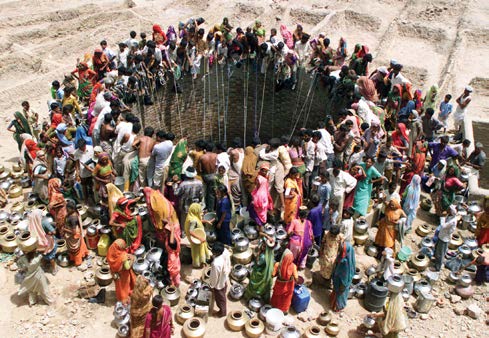The Mounting Water Crisis in India
In India, another developing nation expected to emerge as a global economic growth leader in the next decade, there are worrying problems too. Thought by many to be one of the most dynamic economies among the developing nations, India’s economic potential could very well get derailed or aborted by the nation’s looming water crisis.
The economy, one of the largest in the world, is overly dependent on water, or to be more precise, monsoons. A disappointing monsoon season can wreck havoc on the pace of growth in one of Asia’s largest economies. Given a severe shortage of proper irrigation facilities, the lack of rain is notably difficult for India’s agricultural sector, accounting for nearly onefifth of its gross domestic product. More importantly, roughly twothirds of India’s population relies on farming and related industries. Hence, poor monsoon rains have a huge negative multiplier effect on the rest of the economy.
In particular, the lack of rain can easily and often trigger a hike in food prices, a dynamic that erodes the purchasing power of both urban and rural households. In Mumbai, meanwhile, water rationing is now in place, a step that could slow economic growth in one of India’s most important cities. While the ADB recently forecast that India will confront a serious water crisis by 2020, many believe the crisis will arrive a great deal earlier. Indeed, India is a country under intense water stress. Consider the following:
• India currently has the world’s second largest population, and is expected to overtake China’s by 2050, when it is likely to reach a staggering 1.6 billion, putting unheard of stress on the available water resources. Presently, the nation has 17percent of the world’s population, but only 4 percent of its usable fresh water
• The per capita availability of water in India has dropped from 5,300 cubic meters per annum in 1951 to 1,544 cubic meters in 2011. Thus, the country is already in a ‘water stress’ situation
• Water is under growing pressure both on the supply side (insufficient freshwater, uneven distribution, poor quality, nonrevenue water, climate change), and the demand side (agriculture, industry, residential). Moreover, even the reduced availability of fresh water is highly uneven over time and space
• Besides, the declining per capita availability of water, there are also issues of deteriorating water quality
• According to the World Watch Institute, India suffers from misgovernance on the water pricing front—giving either water free or at heavily subsidized rates. This naturally has led to over-exploitation of ground water and widespread environmental damage
• Water sector is crucial for the Indian economy on account of its growing population and production of goods and services. Water shortages imply a future of food shortages, as well as other essential goods and services shortages
• For years, experts have been issuing warnings about the likely onset of water wars. However, the policymakers have failed to realize the gravity of the situation
• Indian economy has started witnessing the first glimpses of conflicts over water, like many countries in the Middle East, Africa and Central and South Asia. Competition for water is leading to social unrest, conflict, and migration
• India’s 12th Five Year Plan’s (2012-17) thrust is on providing a facilitative environment for the amelioration of water related problems. Time is of essence, however. The country can no longer postpone concert actions to address its water crisis.
All of the above outlines the stark challenge in front of India. The problem is complex—how to provide clean water to a population of over one billion people who are eating better, driving more, and living in urban areas.
The solutions are just as complex and expensive—it will take billions of dollars in investment to head off this crisis. The outcome, however, assuming nothing is done in the immediate future, is rather simple: India will not only fail to grow and prosper but will see its economic development and prosperity retard and diminish.
Economic uncertainty—if not economic and social chaos—will ensue if India does not meet its water challenge.
Solutions
Against a backdrop of global water scarcity, capital expenditures on building and improving water filtration, waste water treatment,desalination, rural water services, water utilities, water utility performance, irrigation systems, and a host of related projects are poised to increase sharply during the next decade. Trillions of dollars are likely to be spent by governments and corporations over the next few decades, a necessary and imperative capital expenditure lest many economies falter and stagnate. The choice is that simple and stark.
The capital has to be spent or countries like India and China will simply not grow. Indeed, their economic development will be reversed; their societies and populations sent reeling backwards instead of forward. In fact, it is these threats and potential solutions for India that form the topic of the following chapters.
In brief, we expect infrastructure expenditures to materialize via public/private partnerships. The Global Water Partnership estimated in 2000 that global water infrastructure requirements would amount to $180 billion per year through 2005—actual annual private investment over the period totalled $3.3 billion, or just 1.8percent of the forecast. Lack of investment has sent fixed water infrastructure into disrepair in many of the world’s fastest growing cities.
Moreover, according to the World Bank, private financing has accounted for less than 10 percent of total water supply and sanitation investment in the developing world to date. With existing water infrastructure strained to the point of capacity, and many emerging market governments flush with capital reserves, thanks to booming trade surpluses, we suspect that future infrastructure build outs will rely on the expediency of private sector expertise and the depth of public sector capital.
Thirsty Nation: Priorities for India’s Water Sector by Joseph P Quinlan, Sumatra Sen and Kiran Nanda (Random House India, Rs. 399)








